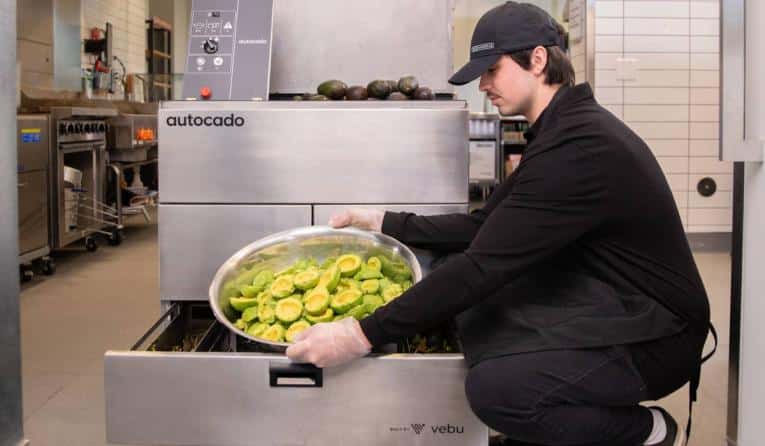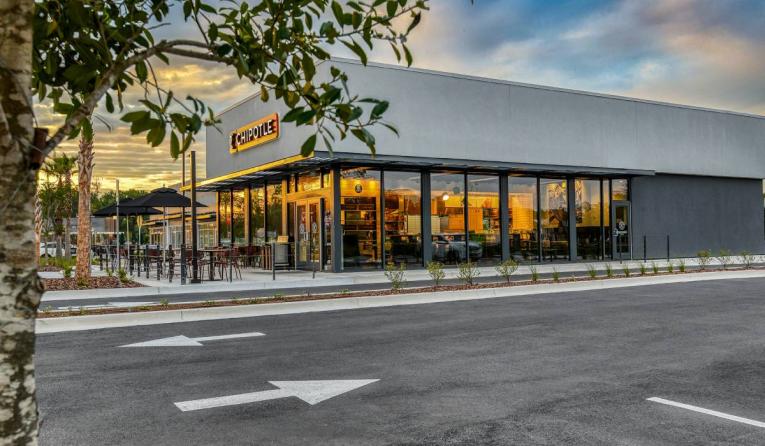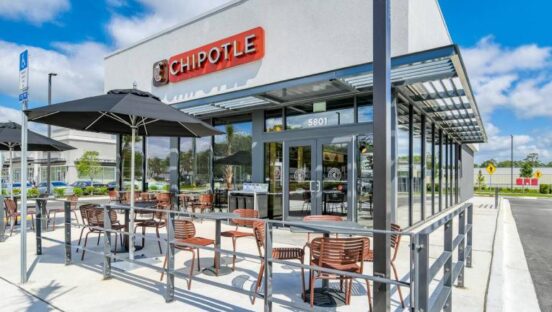Much of Chipotle’s growth and buzz through the pandemic took place outside its restaurants. Digital expansion, rewards (up to 35 million members today), delivery, and the continued leverage of order-ahead pickup “Chipotlanes,” of which there are now more than 600 across North America. Yet as dine-in returned and the brand worked to balance a suddenly oversized part of its business with the comeback of another, it started to recognize opportunities that proved more fundamental than radical.
Chipotle is about to wrap up what it’s termed internally, “Project Square One,” a program rooted in getting back to the basics that began roughly a year ago. CEO Brian Niccol said the brand plans to permanently embed the program within its training DNA. On a quarterly basis, employees will be retrained on key components, ensuring “we never lose sight of training and developing exceptional people and preparing and serving exceptional food,” he said during Chipotle’s Q2 recap.
More current, though, the well-worn topic of throughput surfaced often Wednesday. And it’s a logistical puzzle for the fast casual.
Chipotle tends to have three crew members on the front-line during surges. Niccol said the ideal minimum should be four. Also, the latter employee, who is often the expediter, tends to leave the front line to help the digital one—a reaction that needs to stop. “Our focus will be on coaching the expediter to stay on the front line and to bring together the items, and in order, and communicate them to the cashier,” he said. “Alleviating this bottleneck is critical for delivering great throughput.”
Additionally, Chipotle wants to better optimize smarter pickup times and deployment of labor on the digital line during those peak runs. The brand previously tested changes to the cadence of orders in several markets to see if it could boost service times by eliminating the need to pull a crew member from the front to help out (as mentioned before).
Niccol recently visited a New York City store on 50th and Park and observed noticeable year-over-year improvement from the change. Niccol said the field leader responsible worked with GMs and employees on throughput fundamentals. He regularly followed up with feedback, such as reminding stores to have an expo in position during peaks. By having the proper deployment and the correct balance between the front and digital lines, throughput across the leader’s stores improved by nearly five entrees in the peak 15 minutes as compared to the prior year, Niccol said.
This operational-centric tale is webbing out across Chipotle’s business. The brand recently relaunched “Cultivate University” for promoted field leaders. The three-day training program focuses on fundamentals and will be offered each year to GMs who transition upward, an elevation that sees them go from one store to eight. Niccol added Chipotle is on track to surpass 2022’s 22,000 internal promotions.
The brand’s aim to raise throughput isn’t entirely old-school. Last quarter, Chipotle revealed it was testing dual-sided grills in 10 locations. These cook chicken in less than 4 minutes versus the 12 it takes on Chipotle’s plancha. Steak is ready in sub-1 minute compared to 4. The flip enables the brand to remain in stock when transactions surge and to cook in smaller batches, improving quality and execution. The grills produce the same sear and char, Niccol added, and maintain better moisture, which results in “juicer chicken and steak with less waste.”
The grills also take one of Chipotle’s most complex jobs in-store and lowers the learning curve. Chipotle began a broader rollout of new third-pan rice cookers as well. Here, Chipotle eliminates the large rice pots and cooks rice in “third pans” customers see on the line. It streamlines the rice-cooking process, Niccol said, while allowing employees to make single batches and tap faster recover times. There’s less waste during non-peak stretches and Chipotle can make white and brown rice simultaneously.
The brand rolled the pans out to new restaurants and plans to add to another 200 existing locations this year.

And then there’s the flashier projects, like Chipotle’s “avocado processing cobotic” prototype “Autocado” that cuts, cores, and peels avocadoes before employees hand mash them into guacamole. The collaboration with Vebu, a product development company based out of El Segundo, California, is currently being piloted in Chipotle’s Cultivate Center in Irvine. The automation, with improved processing speeds, can ultimately cut guacamole prep time by 50 percent. It currently takes about 50 minutes per batch.
“As you can see, all of these initiatives have a common goal, which is to improve the in-restaurant experience for our teams and our guests while maintaining or improving upon our high culinary standards,” Niccol said.
William Blair analyst Sharon Zackfia added Chipotle’s throughput objective still has runway. Front-line numbers at peak remain about 10–15 percent below 2019. One positive uptake is Chipotle’s GM turnover is now in the low 20 percent range, “which bodes well for more consistent execution,” Zackfia said.
“I think you have consistency in leadership, consistency in message, we’ll get consistency in execution,” Niccol continued on the topic.
BTIG analyst Peter Saleh said the grills in particular “could also cut down on labor hours, especially when prepping to open the restaurant. With $1.8 billion in cash and manufacturing capacity at the ready, we believe Chipotle could aggressively roll out these grills in the near future.”
Niccol said faster and more consistent cook times would free up capacity and open up Chipotle’s menu innovation, too. It could consider new builds and rethink how long other promotions last. But the biggest benefit boils down to the core. When Chipotle opens at 10:30 in the morning, it doesn’t need to start cooking chicken at 8. In the event a lunch wave arrives at 11 and then 12, employees will be able to recover quicker.
Broadly, getting employees into the throughput mode will take time, Niccol said. Earlier this week, he was in a fully staffed location where everything appeared to be humming along. But it didn’t have “aces and places,” he said. In other words, too many employees were leaving the line to do side tasks and guests began to queue out the door. “I think it’s an element of they got to see it for themselves, they got to experience it, they got to trust it, because sometimes it’s hard,” Niccol said. “I mean, it’s hard to just stay in position when you think you might need some more napkins out by the drink station. It’s like, well, hang in there, get through the line, and then you can go put additional napkins in the drink station.”
Chipotle provided an update on its Hyphen automated makeline, announced last July. The technology is running at the Cultivate Center and has developed, Niccol said, from a concept to a prototype to a working prototype. “We’re getting ready to figure out what the next-gen version of this is,” he said. “But it looks really promising.”
The key components are how fast it can produce bowls per 10 minutes, how accurate, and then Chipotle’s ability to expedite those bowls and get them to the customer in the correct order.
If it continues to grow as it has thus far, Niccol noted, the brand should have something to put into restaurants in the next 12–18 months. “This system could have the ability to revolutionize operations over the coming years,” Saleh said.

Sales, growth, margin, and international prospects
Chipotle’s Q2 same-store sales climbed 7.4 percent, year-over-year, inclusive of over 4 percent traffic (a touch over Q1’s result) and 3 percent average check—5.5 percent price from lapping 4 percent-plus at the end of March. That was partially offset by about 2.5 percent negative mix as smaller groups head back to Chipotle, continuing the recalibration of trends disrupted by COVID’s clamp on mobility. Chipotle’s Chicken Al Pastor LTO, which ends in August and will be followed by a new LTO in late Q3, represented 20 percent of transactions and helped lift performance.
Lower- and upper-income consumers continued to visit, Niccol said, as traffic trends improved from both. Urban restaurants outperformed suburban ones given return-to-work trends. “Management also noted that sales trends normalized more recently following a spike in June when schools let out. In our view, this is further evidence of a very healthy brand with positive traffic despite mid-single digit pricing and upper-teens pricing on a two-year basis,” Saleh said.
Restaurant-level margin climbed 190 basis points sequentially to 27.5 percent, or 230 basis points higher than last year. Zackfia said the figure was Chipotle’s best since 2015, before the food safety crisis.
The brand opened 47 locations in the quarter—40 included Chipotlanes—and exited the period with 3,268 units. This year still calls for 255–285 new venues.
Chipotle recently announced plans to partner with Alshaya Group to open restaurants in the Middle East, a notable call since it brought franchising into the mix for the first time. Niccol said Chipotle scanned the global and saw certain regions where it made sense to go the partner route versus its historic corporate-run growth. “The Middle East is that region,” he said, adding an exact number of projected units isn’t available yet.
That won’t be the case in Western Europe or Canada, where Chipotle will continue to open and direct its own development. Canada has 34 stores presently, with plans for 10 more this calendar.
Chipotle recently brought over one of its top U.S. operators to Europe to drive productivity. “We look forward to continued progress in Europe over the coming quarters as we aim to set up the region for long-term growth,” Niccol said.









